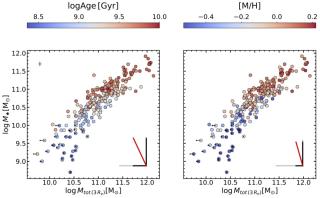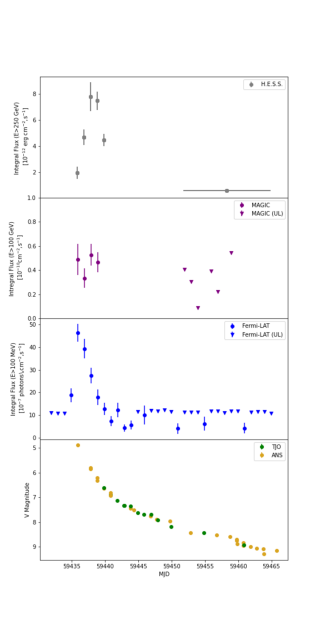Recent observations of the rotation curve of M31 show a rise of the outer part that cannot be understood in terms of standard dark matter models or perturbations of the galactic disk by M31?s satellites. Here, we propose an explanation of this dynamical feature based on the in?uence of the magnetic ?eld within the thin disk. We have considered standard mass models for the luminous mass distribution, a Navarro?Frenk?White model to describe the dark halo, and we have added up the contribution to the rotation curve of a magnetic ?eld in the disk, which is described by an axisymmetric pattern. Our conclusion is that a signi?cant improvement of the ?t in the outer part is obtained when magnetic effects are considered. The best-?t solution requires an amplitude of ?4 ?G with a weak radial dependence between 10 and 38 kpc.
Advertised on
References
(2010) The Astrophysical Journal Letters, Volume 723, Issue 1, pp. L44-L48
It may interest you
-
 Despite the fundamental role that dark matter halos play in our theoretical understanding of galaxy formation and evolution, the interplay between galaxies and their host dark matter halos remains highly debated from an observational perspective. This lack of conclusive observational evidence ultimately arises from the inherent difficulty of reliably measuring dark matter (halo) properties. Based on detailed dynamical modeling of nearby galaxies, in this work we proposed a novel observational approach to quantify the potential effect that dark matter halos may have in modulating galaxyAdvertised on
Despite the fundamental role that dark matter halos play in our theoretical understanding of galaxy formation and evolution, the interplay between galaxies and their host dark matter halos remains highly debated from an observational perspective. This lack of conclusive observational evidence ultimately arises from the inherent difficulty of reliably measuring dark matter (halo) properties. Based on detailed dynamical modeling of nearby galaxies, in this work we proposed a novel observational approach to quantify the potential effect that dark matter halos may have in modulating galaxyAdvertised on -
 Ultra-diffuse galaxies, an extreme type of dwarf galaxy, have been the focus of extensive observational and theoretical studies over the past decade. With stellar masses comparable to dwarf galaxies (between 10 7 and 10 9 solar masses) but much larger in size (as defined by their effective radius), they exhibit an extremely low surface brightness. These galaxies display highly diverse properties: some have large dark matter halos, others lack them, and their number of globular clusters varies widely. Studies of their kinematics and stellar populations have shown that these extreme galaxiesAdvertised on
Ultra-diffuse galaxies, an extreme type of dwarf galaxy, have been the focus of extensive observational and theoretical studies over the past decade. With stellar masses comparable to dwarf galaxies (between 10 7 and 10 9 solar masses) but much larger in size (as defined by their effective radius), they exhibit an extremely low surface brightness. These galaxies display highly diverse properties: some have large dark matter halos, others lack them, and their number of globular clusters varies widely. Studies of their kinematics and stellar populations have shown that these extreme galaxiesAdvertised on -
 The development of the latest generation of Imaging Atmospheric Cherenkov Telescopes (IACTs) over recent decades has led to the discovery of new extreme astrophysical phenomena in the very-high-energy (VHE, E > 100 GeV) gamma-ray regime. Time-domain and multi-messenger astronomy are inevitably connected to the physics of transient VHE emitters, which show unexpected (and mostly unpredictable) flaring or exploding episodes at different timescales. These transients often share the physical processes responsible for the production of the gamma-ray emission, through cosmic-ray accelerationAdvertised on
The development of the latest generation of Imaging Atmospheric Cherenkov Telescopes (IACTs) over recent decades has led to the discovery of new extreme astrophysical phenomena in the very-high-energy (VHE, E > 100 GeV) gamma-ray regime. Time-domain and multi-messenger astronomy are inevitably connected to the physics of transient VHE emitters, which show unexpected (and mostly unpredictable) flaring or exploding episodes at different timescales. These transients often share the physical processes responsible for the production of the gamma-ray emission, through cosmic-ray accelerationAdvertised on